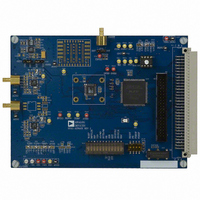EVAL-AD7679CBZ Analog Devices Inc, EVAL-AD7679CBZ Datasheet - Page 22

EVAL-AD7679CBZ
Manufacturer Part Number
EVAL-AD7679CBZ
Description
BOARD EVALUATION FOR AD7679
Manufacturer
Analog Devices Inc
Series
PulSAR®r
Specifications of EVAL-AD7679CBZ
Number Of Adc's
1
Number Of Bits
18
Sampling Rate (per Second)
570k
Data Interface
Serial, Parallel
Inputs Per Adc
1 Differential
Input Range
±VREF
Power (typ) @ Conditions
89mW @ 500kSPS
Voltage Supply Source
Analog and Digital
Operating Temperature
-40°C ~ 85°C
Utilized Ic / Part
AD7679
Lead Free Status / RoHS Status
Lead free / RoHS Compliant
AD7679
SLAVE SERIAL INTERFACE
External Clock
The AD7679 is configured to accept an externally supplied
serial data clock on the SCLK pin when the EXT/ INT pin is
held high. In this mode, several methods can be used to read
the data. The external serial clock is gated by CS . When CS and
RD are both low, the data can be read after each conversion or
during the following conversion. The external clock can be
either a continuous or a discontinuous clock. A discontinuous
clock can be either normally high or normally low when
inactive.
diagrams of these methods.
While the AD7679 is performing a bit decision, it is important
that voltage transients not occur on digital input/output pins or
degradation of the conversion result could occur. This is
particularly important during the second half of the conversion
phase because the AD7679 provides error correction circuitry
that can correct for an improper bit decision made during the
first half of the conversion phase. For this reason, it is
recommended that when an external clock is being provided, it
is a discontinuous clock that toggles only when BUSY is low or,
more importantly, that it does not transition during the latter
half of BUSY high.
Figure 40
SDOUT
CS, RD
CNVST
BUSY
SYNC
SCLK
and
Figure 41
t
16
Figure 39. Master Serial Data Timing for Reading (Read Previous Conversion during Convert)
show the detailed timing
EXT/INT = 0
t
t
14
15
t
X
17
t
t
22
18
t
1
t
D17
3
t
1
20
t
19
t
21
D16
t
23
2
Rev. A | Page 22 of 28
RDC/SDIN = 1
3
External Discontinuous Clock Data Read after
Conversion
This mode is the most recommended of the serial slave modes.
Figure 40 shows the detailed timing diagrams of this method.
After a conversion is complete, indicated by BUSY returning
low, the result of this conversion can be read while both CS and
RD are low. Data is shifted out MSB first with 18 clock pulses,
and is valid on the rising and falling edge of the clock.
Among the advantages of this method, the conversion
performance is not degraded because there are no voltage
transients on the digital interface during the conversion process.
Also, data can be read at speeds up to 40 MHz, accommodating
both slow digital host interface and the fastest serial reading.
Finally, in this mode only, the AD7679 provides a daisy-chain
feature using the RDC/SDIN input pin to cascade multiple
converters together. This feature is useful for reducing
component count and wiring connections when desired (for
instance, in isolated multiconverter applications).
An example of the concatenation of two devices is shown in
Figure 42. Simultaneous sampling is possible by using a
common CNVST signal. It should be noted that the RDC/SDIN
input is latched on the edge of SCLK opposite the one used to
shift out data on SDOUT. Thus, the MSB of the upstream
converter follows the LSB of the downstream converter on the
next SCLK cycle.
16
D2
INVSCLK = INVSYNC = 0
17
D1
18
D0
t
24
03085-0-041
t
t
t
25
27
26


















